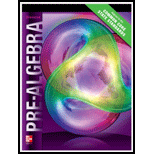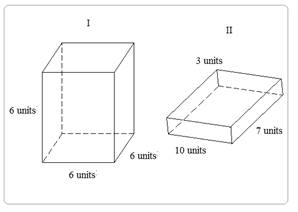
To sketch: two prism such that one has a greater volume and the other has a great surface area.
Answer to Problem 21HP
The figure I has greater volume than figure II but figure II has greater surface area than figure I.
Explanation of Solution
Given:
Consider the figures.

Calculation:
The given figure is a rectangular prism.
The objective is to find the volume and surface area of the two figures.
The volume V of a square prism is given by
The volume V of a rectangular prism is given by
Where l is the length, w is the width and w is the height of the rectangular prism.
The lateral area L of a square prism is given by the formula
Where P is the perimeter of the base and h is the height the square prism.
The surface area S of a square prism is given by the formula
S = L + 2B
Where L is the lateral area and B is the area of the base.
Take the square prism whose side is 6 units.
The volume V of a square prism is
Therefore, the volume of the square prism is
Take the rectangular prism whose length is 10 units, width is 7 units and height is 3 units.
The volume V of a rectangular prism is
Therefore, the volume of the rectangular prism is
Next find the surface area of the square prism.
The perimeter P of the base of the prism is given by
Put P = 24 and h = 6 in the lateral area formula to find the lateral area of the prism.
Thus,
Therefore, the lateral area of the square prism is
First find the area B of the base of the prism. The area B of the base is given by
Put B = 36 and L = 144 in the surface area formula to find the surface area of the prism.
Therefore, the surface area of the square prism is
Now, find the surface area of the rectangular prism.
The perimeter P of the base of the prism is given by
Put P = 34 and h = 3 in the lateral area formula to find the lateral area of the prism.
Thus,
Therefore, the lateral area of the rectangular prism is
First find the area B of the base of the prism. The area B of the base is given by
Put B = 70 and L = 102 in the surface area formula to find the surface area of the prism.
Therefore, the surface area of the rectangular prism is
Conclusion:
Therefore, the figure I has greater volume than figure II but figure II has greater surface area than figure I.
Chapter 12 Solutions
Pre-Algebra Student Edition
Additional Math Textbook Solutions
Basic Business Statistics, Student Value Edition
Algebra and Trigonometry (6th Edition)
A Problem Solving Approach To Mathematics For Elementary School Teachers (13th Edition)
Intro Stats, Books a la Carte Edition (5th Edition)
College Algebra (7th Edition)
Thinking Mathematically (6th Edition)
- 13) Let U = {j, k, l, m, n, o, p} be the universal set. Let V = {m, o,p), W = {l,o, k}, and X = {j,k). List the elements of the following sets and the cardinal number of each set. a) W° and n(W) b) (VUW) and n((V U W)') c) VUWUX and n(V U W UX) d) vnWnX and n(V WnX)arrow_forward9) Use the Venn Diagram given below to determine the number elements in each of the following sets. a) n(A). b) n(A° UBC). U B oh a k gy ท W z r e t ་ Carrow_forward10) Find n(K) given that n(T) = 7,n(KT) = 5,n(KUT) = 13.arrow_forward
- 7) Use the Venn Diagram below to determine the sets A, B, and U. A = B = U = Blue Orange white Yellow Black Pink Purple green Grey brown Uarrow_forward8) Use the Venn diagram provided to shade An Bº. A B U Darrow_forward5) Describe the difference between disjoint sets and overlapping sets.arrow_forward
- 12) Suppose U = {a,b,c,d,e) and A = {a, b, c, e) and B = (c,d,e). Determine (An B).arrow_forward1) Use the roster method to list the elements of the set consisting of: a) All positive multiples of 3 that are less than 20. b) Nothing (An empty set).arrow_forward2) Let M = {all postive integers), N = {0,1,2,3... 100), 0= {100,200,300,400,500). Determine if the following statements are true or false and explain your reasoning. a) NCM b) 0 C M c) O and N have at least one element in common d) O≤ N e) o≤o 1arrow_forward
- 4) Which of the following universal sets has W = {12,79, 44, 18) as a subset? Choose one. a) T = {12,9,76,333, 44, 99, 1000, 2} b) V = {44,76, 12, 99, 18,900,79,2} c) Y = {76,90, 800, 44, 99, 55, 22} d) x = {79,66,71, 4, 18, 22,99,2}arrow_forward3) What is the universal set that contains all possible integers from 1 to 8 inclusive? Choose one. a) A = {1, 1.5, 2, 2.5, 3, 3.5, 4, 4.5, 5, 5.5, 6, 6.5, 7, 7.5, 8} b) B={-1,0,1,2,3,4,5,6,7,8} c) C={1,2,3,4,5,6,7,8} d) D = {0,1,2,3,4,5,6,7,8}arrow_forward5) 8.4 6.3 ?arrow_forward
 Algebra and Trigonometry (6th Edition)AlgebraISBN:9780134463216Author:Robert F. BlitzerPublisher:PEARSON
Algebra and Trigonometry (6th Edition)AlgebraISBN:9780134463216Author:Robert F. BlitzerPublisher:PEARSON Contemporary Abstract AlgebraAlgebraISBN:9781305657960Author:Joseph GallianPublisher:Cengage Learning
Contemporary Abstract AlgebraAlgebraISBN:9781305657960Author:Joseph GallianPublisher:Cengage Learning Linear Algebra: A Modern IntroductionAlgebraISBN:9781285463247Author:David PoolePublisher:Cengage Learning
Linear Algebra: A Modern IntroductionAlgebraISBN:9781285463247Author:David PoolePublisher:Cengage Learning Algebra And Trigonometry (11th Edition)AlgebraISBN:9780135163078Author:Michael SullivanPublisher:PEARSON
Algebra And Trigonometry (11th Edition)AlgebraISBN:9780135163078Author:Michael SullivanPublisher:PEARSON Introduction to Linear Algebra, Fifth EditionAlgebraISBN:9780980232776Author:Gilbert StrangPublisher:Wellesley-Cambridge Press
Introduction to Linear Algebra, Fifth EditionAlgebraISBN:9780980232776Author:Gilbert StrangPublisher:Wellesley-Cambridge Press College Algebra (Collegiate Math)AlgebraISBN:9780077836344Author:Julie Miller, Donna GerkenPublisher:McGraw-Hill Education
College Algebra (Collegiate Math)AlgebraISBN:9780077836344Author:Julie Miller, Donna GerkenPublisher:McGraw-Hill Education





